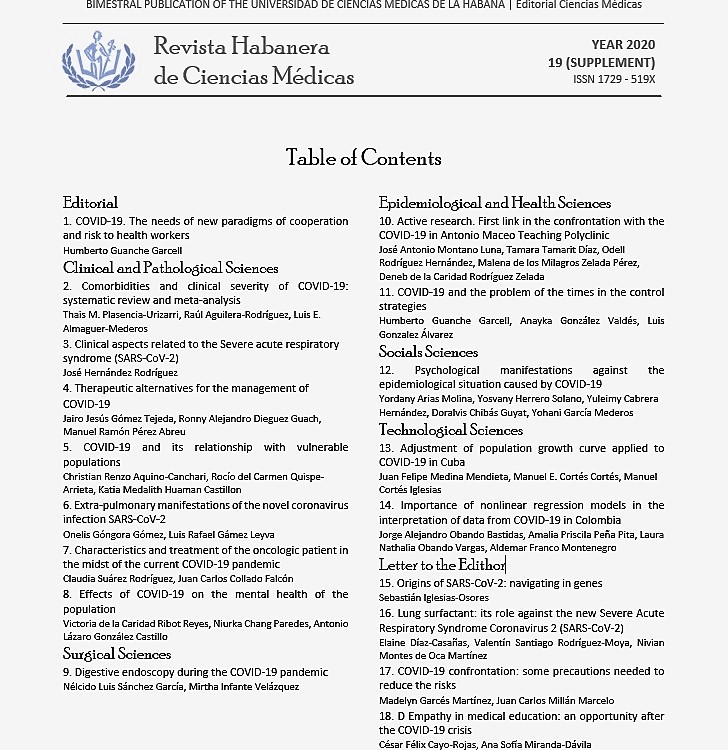Adjustment of population growth curve applied to COVID-19 in Cuba
Keywords:
COVID-19, predictive study, population growth curves, Cuba.Abstract
Introduction: Cuba and all its provinces have been affected by COVID-19 disease. The government and the health system have taken measures to avoid contagion from person to person. To take these measures it is important to have estimates of the rate of infection.
Objectives: To obtain predictions for the peak of infected cases and the total number for some Cuban provinces and the whole country.
Material and Methods: Predictive study of population growth curves. Data from the first 52 days of the disease in the country are processed to estimate the models and to apply the method of least squares estimation of nonlinear parameters. The adjusted coefficient of determination, the Akaike information criterion and the standard error of the residuals are used to measure the goodness of fit of the models. The provinces that present a rate of infection per 100,000 inhabitants greater than 14,71 and the country as a whole are studied.
Results: The goodness of fit of the models used in the provinces studied and the country is high, which allows them to be reliable for predictions.
Conclusions: The predictions suggest that the five provinces analyzed and Cuba show their peak of contagion in April.
Downloads
References
1. Yang Z, Zeng Z, Wang K, Wong SS, Liang W, Zanin M, et al. Modified SEIR and AI prediction of the epidemics trend of COVID-19 in China under public health interventions. J Thorac Dis. 2020;12(3):165.
2. Cagigal MAG, Becario FPU. Modelado y análisis de la evolución de una epidemia vírica mediante filtros de Kalman: el caso de la COVID-19 en España. En: Depósito de investigación de la Universidad de Sevilla [Internet]. España: Universidad de Sevilla; 2020 [Citado 13/05/2020]. Disponible en: https://idus.us.es/bitstream/handle/11441/94508/Analisis%20de%20la%20evolucion%20del%20COVID-19%20con%20Filtros%20de%20Kalman%20v1%20%2801-04-2020%29.pdf?sequence=7&isAllowed=yLo guarde pdf
3. Simón Mínguez F. Procesos de difusión Logístico y Gompertz. Métodos numéricos clásicos en la estimación paramétrica [Tesis de maestría]. España: Universidad de Granada; 2016 [Citado 13/05/2020]. Disponible en: https://masteres.ugr.es/moea/pages/curso201516/tfm1516/simon_minguez_tfm/
4. Jia L, Li K, Jiang Y, Guo X. Prediction and analysis of Coronavirus Disease 2019 [Internet]. Nueva York: ArXiv; 2020 [Citado 13/05/2020]. Disponible en: https://arxiv.org/abs/2003.05447
5. Yang W, Zhang D, Peng L, Zhuge C, Hong L. Rational evaluation of various epidemic models based on the COVID-19 data of China [Internet]. Nueva York: ArXiv; 2020 [Citado 13/05/2020]. Disponible en: http://arxiv.org/abs/2003.05666
6. Batista M. Estimation of the final size of the COVID-19 epidemic [Internet]. Estados Unidos: MedRxiv; 2020 [Citado 13/05/2020].Disponible en: https://www.medrxiv.org/content/10.1101/2020.02.16.20023606v5
7. Dattoli G, Di Palma E, Licciardi S, Sabia E. A Note on the Evolution of Covid-19 in Italy [Internet]. Nueva York: ArXiv; 2020 [Citado 13/05/2020]. Disponible en: http://arxiv.org/abs/2003.08684
8. Remuzzi A, Remuzzi G. COVID-19 and Italy: what next?. The Lancet [Internet]. 2020 Abr [Citado 13/05/2020];395:1225-8. Disponible en: https://www.thelancet.com/article/S0140-6736%2820%2930627-9/abstract
9. Qeadan F, Honda T, Gren LH, Dailey Provost J, Benson LS, Van Derslice JA, et al. Naive Forecast for COVID-19 in Utah Based on the South Korea and Italy Models-the Fluctuation between Two Extremes. Int J Environ Res Public Health [Internet]. 2020 [Citado 13/05/2020];17(8):2750. Disponible en: https://www.ncbi.nlm.nih.gov/pubmed/32316165
10. Villalobos-Arias M. Estimation of population infected by Covid-19 using regression Generalized logistics and optimization heuristics [Internet]. Nueva York: ArXiv; 2020 [Citado 13/05/2020].Disponible en: https://arxiv.org/abs/2004.01207
11. Tátrai D, Várallyay Z. COVID-19 epidemic outcome predictions based on logistic fitting and estimation of its reliability [Internet]. Nueva York: ArXiv; 2020 [Citado 13/05/2020]. Disponible en: https://arxiv.org/pdf/2003.14160
12. Seber GAF. Nonlinear Regression Models. En su: The Linear Model and Hypothesis: A General Unifying Theory. Cham [Internet]. Nueva York: Springer International Publishing; 2015 p.117-28 [Citado 13/05/2020]. Disponible en: https://www.springer.com
13. Moamer S, Baghestani AR, Pourhoseingholi MA, Maboudi AAK, Shahsavari S, Zali MR, et al. Application of the parametric regression model with the four-parameter log-logistic distribution for determining of the effecting factors on the survival rate of colorectal cancer patients in the presence of competing risks. Iran Red Crescent Med J [Internet]. 2017 [Citado 13/05/2020];19(6):[aprox. 2 p.]. Disponible en: https://sites.kowsarpub.com/ircmj/articles/13185.html
14. Finney DJ. Bioassay and the practice of statistical inference. Int Stat Rev Int Stat [Internet]. 1979 [Citado 13/05/2020];47(1):1-12. Disponible en: https://www.sciencedirect.com/science/article/pii/0169260796017257/
15. Kyurkchiev N, Iliev A. Extension of Gompertz-type Equation in Modern Science: 240 Anniversary of the birth of B. Gompertz. [Internet]. Deutschland: LAP LAMBERT Academic Publishing; 2018 [Citado 13/05/2020].
16. Wais P. A review of Weibull functions in wind sector. Renew Sustain Energy Rev. 2017;70:1099-1107.
17. Brain P, Cousens R. An equation to describe dose responses where there is stimulation of growth at low doses. Weed Res. 1989;29(2):93-6.
18. Groot JCJ, Cone JW, Williams BA, Debersaques FMA, Lantinga EA. Multiphasic analysis of gas production kinetics for in vitro fermentation of ruminant feeds. Anim Feed Sci Technol. 1996;64(1):77-89.
19. Ricketts JH, Head GA. A five-parameter logistic equation for investigating asymmetry of curvature in baroreflex studies. Am J Physiol-Regul Integr Comp Physiol. 1999;277(2):R441-R454.
20. R: The R Project for Statistical Computing [Internet]. Austria: R Foundation for Statistical Computing; 2018. [Citado 13/05/2020]. Disponible en: https://www.r-project.org/
21. Colin Cameron A, Windmeijer FAG. An R-squared measure of goodness of fit for some common nonlinear regression models. J Econom. 1997;77(2):329-42.
22. Osuji GA, Okoro CN, Obubu M, Obiora Llouno HO. Effect of akaike information criterion on model selection in analyzing auto-crash variables. Int J Sci Basic Appl Res. 2016;26(1):98-109.
23. Draper NR, Smith H. Applied regression analysis [Internet]. 3ra ed. United States: John Wiley & Sons; 1998 [Citado 13/05/2020]. Disponible en:
https://www.wiley.com/en-us/Applied+Regression+Analysis%2C+3rd+Edition-p-9780471170822
24. Neill JW. Testing for lack of fit in nonlinear regression. Ann Stat. 1988;16(2):733-40.



